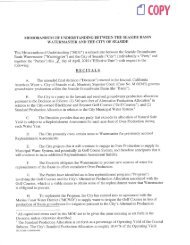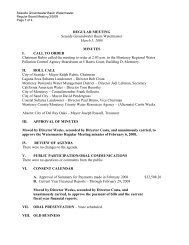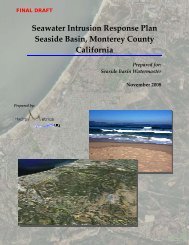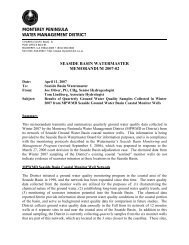groundwater flow and transport model seaside groundwater basin ...
groundwater flow and transport model seaside groundwater basin ...
groundwater flow and transport model seaside groundwater basin ...
Create successful ePaper yourself
Turn your PDF publications into a flip-book with our unique Google optimized e-Paper software.
Seaside Model Report<br />
October 26, 2007<br />
Introduction<br />
1.0 Introduction<br />
1.1 Purpose <strong>and</strong> Scope of Report<br />
The Seaside <strong>groundwater</strong> <strong>basin</strong>, which is located adjacent to <strong>and</strong> beneath<br />
Monterey Bay (Figure 1.1), has been the subject of an ongoing adjudication.<br />
Groundwater pumping exceeds the natural <strong>and</strong> secondary recharge, <strong>groundwater</strong> levels<br />
have been declining, <strong>and</strong> the adjudication has focused on the corresponding threat of<br />
seawater intrusion. While seawater intrusion has not been detected, except near Marina,<br />
the parties to the adjudication recognized the inevitability of eventual seawater intrusion<br />
were existing conditions to continue. However, the parties did dispute the best approach<br />
to addressing the threat, with respect to both the institutional setting <strong>and</strong> the physical<br />
solution.<br />
A trial was held during late 2005 in the Monterey County Superior Court to<br />
adjudicate the disputed issues. The outcome was that the Court ordered the creation of a<br />
Watermaster, which was to be comprised of a collective of water users. The Watermaster<br />
was directed to monitor <strong>groundwater</strong> conditions, develop a physical solution, <strong>and</strong><br />
implement the solution. The Court directed that the Watermaster report periodically to<br />
the Court on progress toward meeting it obligations.<br />
An obligation of the Watermaster is to develop a <strong>groundwater</strong> <strong>model</strong>. During the<br />
trial, the testimony for the California-American Water Co. included the description of a<br />
<strong>groundwater</strong> <strong>model</strong>, which was used to evaluate the threat of seawater intrusion. In its<br />
post-trail decision, the Court ordered the creation of a <strong>groundwater</strong> <strong>model</strong>. Subsequently,<br />
the Watermaster decided the <strong>groundwater</strong> <strong>model</strong> developed for California American<br />
Water could meet the current <strong>basin</strong>-management needs. That <strong>model</strong> includes both<br />
<strong>groundwater</strong> <strong>flow</strong> <strong>and</strong> solute <strong>transport</strong> components. The trial testimony did not include<br />
written documentation of the <strong>model</strong>, which the Watermaster needs in order to use the<br />
<strong>model</strong>.<br />
This report represents the needed documentation. The objective of the report is to<br />
describe the available data, the use of the data to develop the <strong>model</strong>, the predictive<br />
simulations, <strong>and</strong> the structure of the <strong>model</strong> input files. The documented <strong>model</strong> is the<br />
same as that presented to the court during the trial.<br />
1.2 Description of Study Area<br />
1.2.1 Physiographic Features<br />
The Seaside <strong>groundwater</strong> <strong>basin</strong> underlies the hills <strong>and</strong> coastal plane at the<br />
northern end of the Sierra de Salinas (Figure 1.2). The principal drainages are Arroyo del<br />
Rey <strong>and</strong> El Toro Creek. Arroyo del Rey is a northwestward <strong>flow</strong>ing tributary to<br />
Monterey Bay. El Toro Creek is a northeastward <strong>flow</strong>ing tributary to the Salinas River.<br />
1






